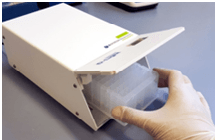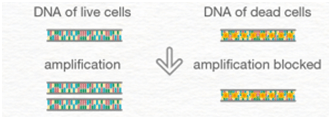Comments about “Modified Polymerase Chain Reaction Distinguish between Live and Dead Bacteria”
 The blog about PCR and distinguishing between live and dead bacteria have drawn some comments as shown below:
The blog about PCR and distinguishing between live and dead bacteria have drawn some comments as shown below:
Gerold Schwarz You might have a look for Reagent D – we established a protocol for Enterobacteriaceae in instant milk formula and Yeast and Mold in dairy products – it works similar utilizing a halogen light in addition source to eliminate dead cells before amplification.
Gerold Schwarz Send the following additional Information:
By: Dr. Gerold Schwarz, Produktmanager BIOTECON Diagnostics GmbH
Elimination of DNA form dead cells prior a PCR-Setup:
Reagent D is designed for the rapid elimination of DNA from dead cells to avoid false-positive PCR results. The reagent contains a light sensitive substance which can penetrate the cell membranes of dead cells, whereas the outer membrane compartments of living cells can actively protect their cytosolic compartments.
- After a brief incubation of a freshly prepared enrichment culture with reagent D.

- The complete Assay is exposed 5 minutes to a high-power halogen light source.

- Isolate/ extract DNA
- Run PCR
After incubation with light the DNA is irreversibly lin ked and amplification is blocked.
ked and amplification is blocked.
- Final PCR Results and no or low false positive rates.
We have tested and validated the procedure for our foodproof Enterobacteriaceae plusCronobacter Detection Kit and the foodproof Yeast & Mold Quantification LyoKit and third with the foodproof Vibrio Detection LyoKit.
Other Comments:
Relating to the original Blog:
Angela Aucoin This could be invaluable in reducing or eliminating triple re-examination costs of false positive environmental samples
Peter Ball Similar methods using propidium monoxide and ethidium monoxide have been published multiple times and are well known to most working with QPCR.
Francesc Codony Iglesias The dynamic approach in vPCR has been suggested in the past , mainly by Dr Soejima working with different chemical compounds based on Pt and Pd. In the patent appointed by Ruth the authors also are following the dynamic approach, with a phenantridinium dimer. Although the dye interaction is quite strong, it’s not irreversible therefore during PCR denaturation this DNA will be available for amplification. For this purpose I opine that photo-reactive phenantridiniums are better reagents because their reagents can be activated by light and the binding to DNA is irreversible. Otherwise during sampling transport and handling, it’s quite critical in some clinical and food applications, the reagent will remain active affecting post sampling damaged cells. Regarding the patent, probably the inventive novelty can be refuted during future examinations.
John Mackay Use of PMA etc is patented – does this method vary sufficiently? Although doesn’t seem to need cross-linking. Patent describes a comparison among the dyes.
